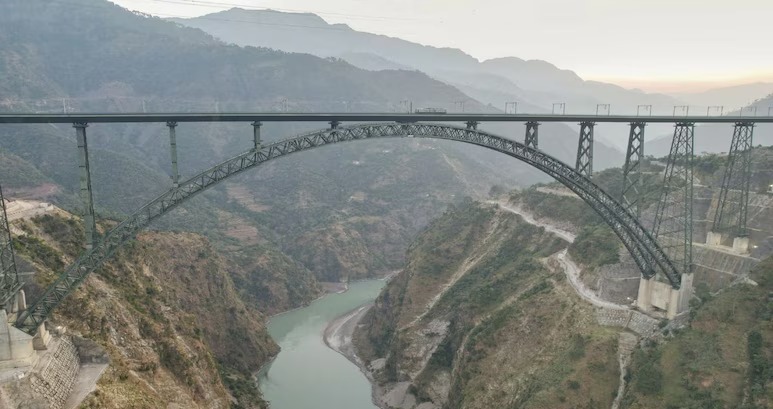Table of Contents
The Chenab Bridge, also known as the Chenab Railway Bridge, stands as a shining symbol of India’s engineering excellence and determination. Situated in the Reasi district of Jammu & Kashmir, this iconic structure is the world’s highest railway arch bridge, connecting Kashmir to the rest of India through the Udhampur-Srinagar-Baramulla Rail Link (USBRL) project.
What is the Chenab Bridge?
The Chenab Bridge is a massive steel arch railway bridge built across the deep gorge of the Chenab River in the Himalayas. It is part of the larger USBRL project that aims to provide all-weather rail connectivity to the Kashmir Valley, a region long challenged by difficult terrain and harsh winters.
Key Facts About the Chenab Railway Bridge
| Feature | Detail |
|---|---|
| Location | Reasi District, Jammu & Kashmir |
| Height Above Riverbed | 359 meters (1,178 feet) |
| Length | 1,315 meters (4,314 feet) |
| Bridge Type | Steel Arch Railway Bridge |
| Construction Cost | Approx. ₹1,486 crore |
| Completion Year | 2025 |
| Arch Span Length | 467 meters |
| Wind Resistance | Up to 260 km/h |
| Designed Lifespan | 120 years |
| Steel Used | Over 60,000 tonnes |
| Welding Length | 600 km (longer than the distance from Jammu to Delhi) |
| Record | World’s Highest Railway Arch Bridge |
Why is the Chenab Bridge Significant?
-
World Record Holder: The Chenab Bridge is the highest railway bridge in the world, towering 359 meters above the Chenab River, making it taller than the Eiffel Tower by 35 meters.
-
Engineering Feat: The bridge uses a steel arch design that withstands extreme weather, including heavy winds (up to 260 km/h), seismic activity, and temperature fluctuations ranging from -20°C to +40°C.
-
Strategic Importance: By connecting Kashmir with the rest of India, the bridge strengthens national integration, facilitates economic development, and enhances accessibility to remote regions.
-
All-Weather Connectivity: The USBRL project, including this bridge, ensures year-round rail service to Kashmir despite heavy snowfall and landslides, replacing the traditional dependence on roadways vulnerable to weather disruptions.
-
Technological Innovations: The construction involved advanced welding techniques, seismic shock absorbers, and corrosion-resistant steel to ensure durability and safety.
Construction Challenges of the Chenab Railway Bridge
Building a bridge of this magnitude in one of the world’s most challenging terrains posed several difficulties:
-
Geographical Hurdles: The steep gorge, difficult topography, and extreme altitude made transporting materials and machinery a major challenge.
-
Harsh Weather Conditions: Frequent snowfall, strong winds, and temperature extremes required an innovative design to ensure structural stability and safety.
-
Safety Risks: Workers faced hazardous conditions working at great heights and remote locations, demanding strict safety protocols.
-
Seismic Activity: The region is prone to earthquakes, requiring the bridge to be designed with seismic dampers and flexible structures to absorb shocks.
Despite these challenges, the project was completed successfully with high precision and quality.
Role of Chenab Bridge in the Udhampur-Srinagar-Baramulla Rail Link (USBRL)
The Chenab Bridge is a critical component of the USBRL project, which aims to connect Kashmir Valley with Jammu and the rest of India by rail for the first time. The rail link:
-
Covers a total length of 272 km
-
Includes 36 tunnels spanning over 119 km
-
Has 943 bridges crossing deep valleys and rivers
-
It is designed to withstand the harsh Himalayan climate
-
Provides faster, safer, and more reliable transportation options for passengers and freight
Impact of Chenab Bridge on Jammu & Kashmir and India
-
Boost to Tourism: Improved connectivity will attract more tourists to the scenic Kashmir Valley, promoting local businesses and cultural exchange.
-
Economic Development: Easier movement of goods and people will accelerate trade, industry, and agriculture in the region.
-
Strategic & Security Benefits: The bridge enhances logistics and rapid deployment capabilities for defence forces in the sensitive border area.
-
Social Integration: It fosters a greater sense of unity by physically linking Kashmir to the Indian mainland.
Future Prospects
The successful inauguration of the Chenab Railway Bridge paves the way for:
-
The launch of Vande Bharat trains on the route offers modern, fast, and comfortable rail travel.
-
Completion of the entire USBRL project, including other major bridges like the Anji Khad Cable-Stayed Bridge.
-
Enhanced multi-modal connectivity with road and air transport.
-
Further infrastructure projects to develop the region sustainably.
The Chenab Railway Bridge is more than just an architectural marvel; it is a testament to India’s engineering prowess and determination to connect its most remote regions. As the world’s highest railway bridge, it symbolises hope, progress, and unity for Jammu and Kashmir and the nation as a whole.


 National Project for Strengthening Disas...
National Project for Strengthening Disas...
 CAG Report on Pradhan Mantri Kaushal Vik...
CAG Report on Pradhan Mantri Kaushal Vik...
 NITI Aayog Report on Public R&D Inst...
NITI Aayog Report on Public R&D Inst...

























